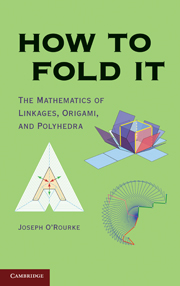PART III - Polyhedra
Published online by Cambridge University Press: 05 June 2012
Summary
The third and final part of this book explores folding and unfolding the surface of a polyhedron, a 3D solid shape whose surface is made of flat faces. We break the tradition of the previous two parts of always including at least one beautiful theorem in each chapter, for a central question in unfolding polyhedra has so resisted solution that there are as yet no general theorems. We explain this central open problem, “Dürer's Problem” for convex polyhedra, in the next chapter, and follow that with a variation for “orthogonal polyhedra” on which there are results to report. We close with the inverse of unfolding, folding a piece of paper to a polyhedron, which has at its core a beautiful and powerful theorem of the Russian geometer Alexandr Alexandrov. Investigation of folding polyhedra has led to many surprises and leads to several unsolved but accessible problems for the reader to ponder.
Information
- Type
- Chapter
- Information
- How to Fold ItThe Mathematics of Linkages, Origami, and Polyhedra, pp. 99 - 100Publisher: Cambridge University PressPrint publication year: 2011
